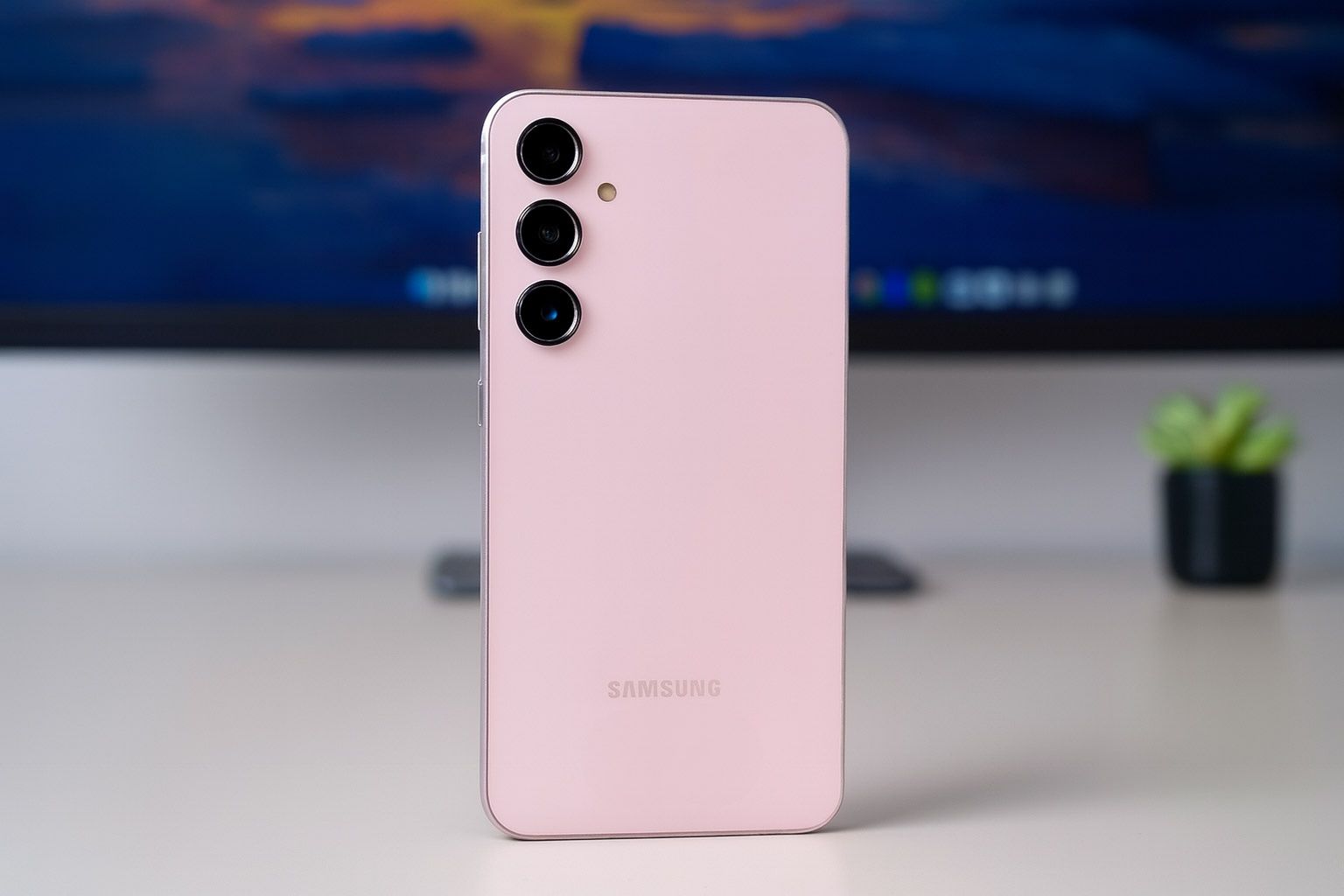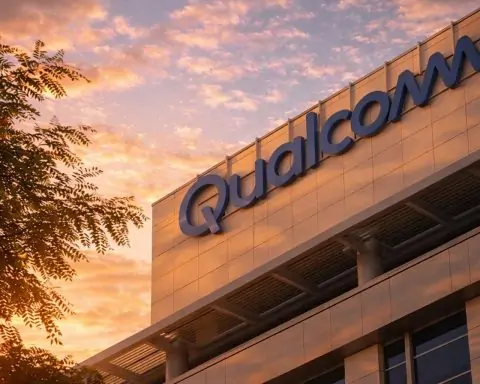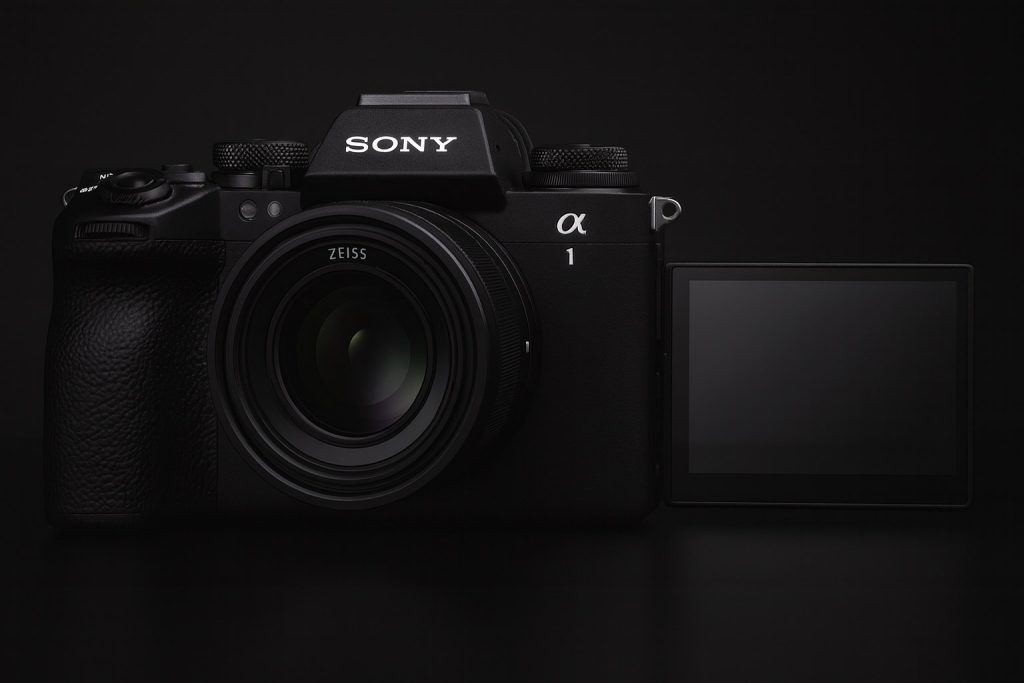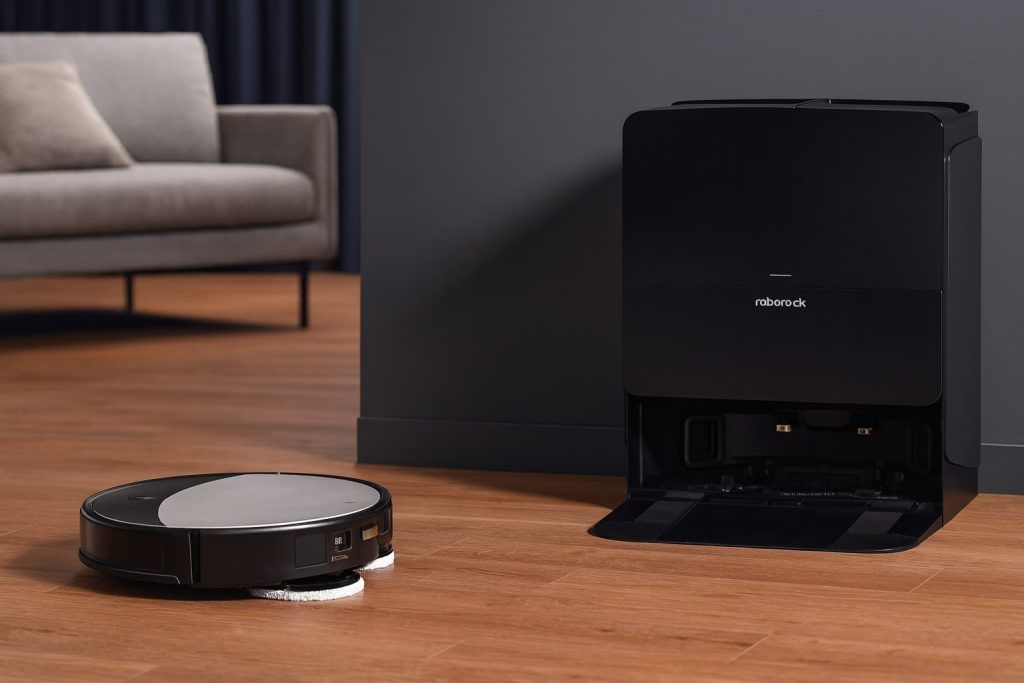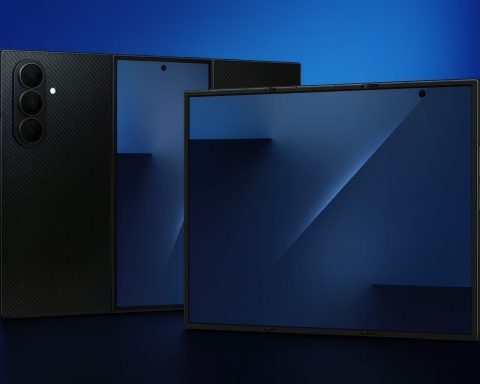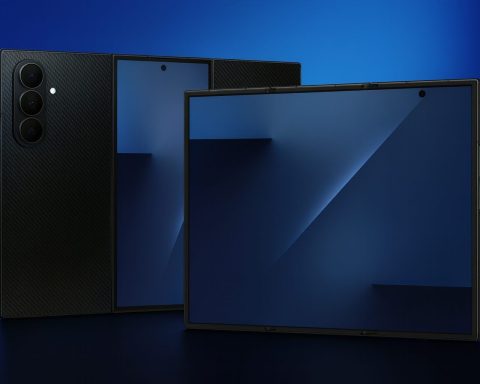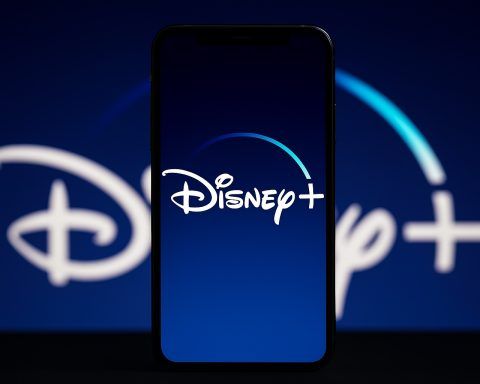- In March 2024 Samsung launched the Galaxy A55 5G (global ex-US), Galaxy A35 5G (US and global), and Galaxy M55 5G (select markets).
- The Galaxy A55 5G uses the Exynos 1480 (5 nm) with four cores up to 2.75 GHz and an AMD Xclipse 530 GPU, faster in CPU and GPU than the A35’s Exynos 1380.
- All three models carry a 5,000 mAh battery, while the M55 charges at 45 W and the A35 and A55 charge at 25 W.
- The A55 and A35 have a 6.6-inch Full HD+ 120 Hz Super AMOLED display, while the M55 has a 6.7-inch Full HD+ 120 Hz Super AMOLED Plus display.
- All three use a 50 MP main rear camera with OIS, but the A55 adds a 12 MP ultrawide and a 5 MP macro, while the A35 uses an 8 MP ultrawide and 5 MP macro, and the M55 uses an 8 MP ultrawide and 2 MP macro.
- The A55 front camera is 32 MP, the A35 front camera is 13 MP, and the M55 front camera is 50 MP in selfies.
- The A55 and A35 use metal frames with glass backs and IP67 water/dust resistance, while the M55 uses a plastic frame/back with no IP rating and Dragontrail glass.
- All three run Android 14 with One UI 6.1 at launch and come with a 4 OS upgrades plus 5 years of security updates promise.
- Launch prices were around $399 for the A35, €479 for the A55 (roughly $520) in Europe, and ₹24,999 (~$300) for the M55 in India, with the M55 often found around $270–$300 elsewhere.
- Technically, the A35 offers the best value for mainstream buyers, the A55 provides the best overall polish and camera performance, and the M55 delivers the most specs per dollar with some tradeoffs in build and camera quality.
Samsung’s Galaxy A and M series phones have become the go-to options for budget-conscious consumers seeking Galaxy features without flagship prices. In 2024, three notable midrange models emerged – the Galaxy A55 5G, Galaxy A35 5G, and Galaxy M55 5G. All three pack big batteries, high-refresh displays, and multi-camera arrays, but they target slightly different audiences. The A55 is the premium mid-ranger (succeeding the popular A54) sold in markets like Europe and Asia, while the A35 is a more affordable variant (available in the US and elsewhere) with a few pared-down specs [1] [2]. The M55, on the other hand, is part of Samsung’s online-focused M series, offering some surprising firsts (like faster charging and a high-res selfie camera) but also a few sacrifices [3] [4].
Below, we’ll compare specifications, performance benchmarks, camera quality, design and build, display, battery life, software support, pricing, and overall value of the Galaxy A55 vs A35 vs M55. We’ll also highlight insights from tech experts and include the latest news/rumors on upcoming Galaxy A and M models to put these phones in context. Let’s dive into Samsung’s midrange showdown and see which phone offers the best bang for your buck in 2024!
Specs Comparison Table
To start, here’s a side-by-side look at the key specifications of the Galaxy A55, A35, and M55:
| Model | Samsung Galaxy A55 5G | Samsung Galaxy A35 5G | Samsung Galaxy M55 5G |
|---|---|---|---|
| Release | Mar 2024 (global ex-US) | Mar 2024 (US & global) | Mar 2024 (select markets) |
| Price (Launch) | €479 (128GB) ($520) [5] | $399 / £339 / €379 (128GB) [6] [7] | ~₹26,999 (≈$325) in India [8] [9] |
| Display | 6.6″ Super AMOLED, FHD+ (1080×2340), 120 Hz [10] [11], Gorilla Glass Victus+ | 6.6″ Super AMOLED, FHD+ (1080×2340), 120 Hz [12], Gorilla Glass Victus+ | 6.7″ Super AMOLED Plus, FHD+ (1080×2400), 120 Hz, Gorilla Glass (Dragontrail) [13] [14] |
| Processor (SoC) | Exynos 1480 (5 nm, octa-core @ 2.75 GHz + 2.0 GHz) [15] [16] – AMD Xclipse 530 GPU (RDNA2) | Exynos 1380 (5 nm, octa-core @ 2.4 GHz + 2.0 GHz) – Mali-G68 GPU [17] | Qualcomm Snapdragon 7 Gen 1 (4 nm, octa-core @ 2.4 GHz/2.36 GHz/1.8 GHz) [18] – Adreno 644 GPU |
| Memory & Storage | 8 GB or 12 GB RAM; 128 GB or 256 GB storage (microSD up to 1 TB) [19] [20] | 6 GB or 8 GB RAM; 128 GB (256 GB option in some regions) (microSD up to 1 TB) [21] [22] | 8 GB RAM (12 GB special variant); 128 GB storage (expandable via microSD) [23] [24] |
| Rear Cameras | Triple: 50 MP f/1.8 main (OIS) + 12 MP f/2.2 ultrawide + 5 MP f/2.4 macro [25] (no telephoto) | Triple: 50 MP f/1.8 main (OIS) + 8 MP f/2.2 ultrawide + 5 MP f/2.4 macro [26] | Triple: 50 MP f/1.8 main (OIS) + 8 MP f/2.2 ultrawide + 2 MP f/2.4 macro [27] (downgrade from 108 MP on M54 [28]) |
| Front Camera | 32 MP f/2.2 selfie (4K30 video support) [29] [30] | 13 MP f/2.2 selfie (1080p video) [31] [32] | 50 MP selfie (first Samsung with 50MP front) [33] – (image quality similar to 32MP cams) [34] |
| Battery | 5,000 mAh (2-day rated), 25 W wired fast charging (no wireless) [35] [36] | 5,000 mAh, 25 W wired charging (no wireless) [37] | 5,000 mAh, 45 W Super Fast Charging (no wireless) [38] [39] |
| Build & Design | Premium: Aluminum frame, glass back (Gorilla Victus+), IP67 water/dust resistant [40] [41]; 8.2 mm thick, ~213 g | Premium: Aluminum frame, glass back (Gorilla Victus+), IP67 rated [42]; 8.2 mm, 209 g [43] [44] | Budget: Plastic frame & back (no IP rating) [45] [46]; slim 7.8 mm profile, only 180 g [47] |
| Audio & Extras | Stereo speakers; no 3.5mm jack; in-display optical fingerprint | Stereo speakers; no 3.5mm jack; in-display fingerprint (slower scanner) [48] [49] | Stereo speakers (poor quality) [50] [51]; no 3.5mm jack; in-display fingerprint (1st in M series) [52] |
| Software (Launch) | Android 14 w/ One UI 6.1; 4 years of OS updates & 5 years security patches promised [53] [54] | Android 14 w/ One UI 6.1; 4 OS upgrades & 5 years security updates [55] | Android 14 w/ One UI 6.1; 4 OS upgrades & 5 years security updates (first M-series with this level of support) |
Sources: Samsung official specs and multiple reviews [56] [57].
As the table shows, the Galaxy A55 and A35 share many traits – same screen size/tech, battery, and main camera resolution – but the A55 steps up performance and camera capabilities, while the A35 trims a few features to hit a lower price. The M55 in turn offers a mix of pros and cons: it has the largest display and fastest charging of the trio, and even a record-breaking selfie camera resolution, but it cuts corners in build quality and camera hardware (using a lower-res macro lens and lacking water resistance). Next, we’ll break down each category in detail with insights from experts.
Design & Build Quality
In terms of design and durability, the Galaxy A55 and A35 feel surprisingly premium for midrange phones, whereas the M55 is more utilitarian. Both A-series models feature a modern flat-frame design with metal sides and glass front/back, closely resembling Samsung’s flagship style [58] [59]. In fact, TechRadar notes the A35’s glass back “makes it feel more premium in the hand than many other mid-range phones” [60] [61]. Both A55 and A35 are also rated IP67 for water and dust resistance, meaning they can survive submersion up to 1m for 30 minutes [62] – a rarity at these price points. Reviewers praised the solid build of the A35, calling its design “smooth and flat, with an intuitive grip” and appreciating that Samsung didn’t skimp on materials [63] [64].
The Galaxy M55, by contrast, does not have an official IP rating and initially came with a plastic body (frame and back), lacking the luxe feel of its A-series siblings [65] [66]. SamMobile points out that Samsung omitted “premium design elements” on the M55: there’s no aluminum frame or glass back, and the display is protected by Asahi Dragontrail glass instead of Gorilla Glass [67] [68]. This makes the M55 a bit less robust against scratches and drops – something reviewers weren’t thrilled about (“Not having Gorilla Glass protection isn’t illegal, but in 2024, maybe it should be” quipped one review [69]). On a positive note, the M55 doesn’t feel cheap in hand – it has a smooth matte finish and is remarkably slim (7.8 mm) and light (180 g), making it “feel very sleek” compared to the thicker A-series models [70] [71]. “Thanks to the 7.8 mm thickness, the M55 feels very sleek,” wrote SamMobile, though they added that its design is otherwise plain and lacks the polished touches of the A-series [72] [73].
In terms of looks, all three phones adopt Samsung’s minimalist aesthetics: “linear” rear camera layout (three separate lens cut-outs with no camera bump housing) and flat displays. Color options vary – the A35 and A55 come in trendy hues like Awesome Ice Blue, Lilac, Lemon (pale yellow) and Navy [74] [75]. The M55 launched in basic Dark Blue or Light Green [76] [77] (though Samsung later released rebranded variants with more stylish finishes – e.g. a Galaxy F55 model with a leather back for certain markets [78] [79]).
Overall, if you value premium build and durability, the Galaxy A55 and A35 clearly have the edge with their metal-and-glass construction and waterproofing [80] [81]. The M55’s design prioritizes slimness and weight, but you’ll be giving up high-end materials and any water/dust protection (Samsung even openly “wishes” to bring water resistance to the M series in the future [82] [83]). For many buyers, those durability features on the A-series can provide peace of mind – as one reviewer said, “having a traditional and unassuming design isn’t illegal… but maybe Gorilla Glass should be [standard]” on all phones [84].
Display
All three devices offer large, vibrant displays – a traditional Samsung strong point. The Galaxy A55 and A35 share the same screen specs: a 6.6-inch Super AMOLED panel with Full HD+ resolution (~1080×2340) and a fast 120 Hz refresh rate [85] [86]. This means you get bright colors, deep contrast, and silky-smooth scrolling on either device. Tom’s Guide praised the A35’s display as “bright [and] colorful” [87] and TechRadar went as far as to call it “big, bold, bright, vibrant, and [just] nice to look at” – perfect for Netflix or Disney+ streaming [88] [89]. Both screens also benefit from Samsung’s Vision Booster technology (improving outdoor visibility by adjusting contrast/color under harsh light) and can hit around 1000 nits peak brightness, enough to remain readable in sunlight [90] [91].
The Galaxy M55 actually has a slightly larger display at 6.7 inches, using a Super AMOLED Plus panel with a 20:9 aspect ratio (1080×2400) [92]. It too runs at 120 Hz and reaches 1000 nits peak brightness, delivering an “immersive experience” similar to the A-series [93]. Reviewers noted the M55’s colors are just as punchy and its brightness “sufficient for every environment” [94] [95]. One advantage on the M55: Samsung managed to trim the bezels a bit, so it has a slightly higher screen-to-body ratio than the A35/A55 (not quite flagship-thin borders, but a nice touch) [96] [97].
In everyday use, you’d be hard-pressed to tell a big difference between these displays – all are Full HD AMOLEDs with 120 Hz, providing a lively and fluid viewing experience. The extra 0.1″ on the M55 is negligible, though its aspect ratio is a tad taller. The A55 and A35 have the benefit of Gorilla Glass Victus+ protection on the display (versus Dragontrail on M55), which might better resist scratches over time [98]. But purely for screen quality, Samsung’s midrange displays are excellent across the board. As TechAdvisor put it when testing the A35: “Samsung’s fantastic display tech is shining brightly [here]”, easily satisfying content consumption needs [99] [100].
Performance & Benchmarks
Under the hood, the Galaxy A55 is the most powerful of the trio, thanks to its new Exynos 1480 chipset – and this showed in benchmarks. The Exynos 1480 is Samsung’s 2024 midrange SoC built on a 5nm process, featuring four high-performance cores at 2.75 GHz and a new AMD-based Xclipse 530 GPU [101] [102]. It’s a notable upgrade over the Exynos 1380 in the A35, offering around 22% faster CPU performance and 31% faster graphics according to leaks [103]. In practical terms, the A55 breezed through productivity tasks: “The PCMark Work test yields top-notch results… suggesting plenty of system optimizations” and overall the phone feels smooth in everyday use [104] [105]. Android Authority’s review found real-world performance excellent – the A55 kept the interface fluid and could even run heavy games like Genshin Impact at low/medium settings near 60 fps without major throttling [106] [107]. In their words, “The Galaxy A55 5G is far from the most powerful mid-range phone, but it performed surprisingly well with some demanding apps.” [108] Compared to pricier rivals, the A55’s GPU still isn’t a champion (it “lags far behind the Pixel 8a and OnePlus 12R” in 3D graphics tests) [109] [110], but it’s a solid performer for its class.
The Galaxy A35 uses last year’s Exynos 1380 – a decent midrange chip with four Cortex-A78 cores up to 2.4 GHz (plus four A55 efficiency cores) and a Mali-G68 GPU [111]. In day-to-day tasks, the A35 holds up well: the UI is snappy and it can handle multitasking and casual games comfortably. TechRadar was actually impressed, calling the chipset “a surprising feature” that “absolutely cracks through long gaming bouts or intensive tasks; mobile gamers won’t find anything to turn their nose up at here.” [112] [113] That might be a bit generous – in objective terms the Exynos 1380 is a tier below the A55’s chip. For example, the Snapdragon 7 Gen 1 (used in the M55) is “slightly faster than the Exynos 1380 … and around 10–15% slower than the Exynos 1480 inside the Galaxy A55” according to SamMobile’s tests [114] [115]. So the A35 will typically trail the A55 by roughly ~15% in CPU speed and more in GPU-heavy scenarios. Indeed, Tom’s Guide found the A35 was “outperformed by other midrange models” in its class [116] – not a slow phone by any means, but lacking the extra headroom of the A55 or some competitors.
Interestingly, the Galaxy M55 employs Qualcomm’s Snapdragon 7 Gen 1, which gives it a unique performance profile. This 4nm chip has a similar octa-core setup (with Cortex-A710 cores up to 2.4 GHz) and an Adreno 644 GPU [117]. On paper the Snapdragon 7 Gen1’s CPU is a tad weaker than the A55’s Exynos 1480, but its GPU/driver optimizations can actually outperform the Exynos in gaming. SamMobile observed that in titles like Call of Duty: Mobile, the M55’s Snapdragon allowed higher graphics settings than either Exynos chip: “In CoD, Snapdragon 7 Gen 1 lets you enable Very High graphics + Max frame rate; the Exynos 1380 tops out at High, and the Exynos 1480 limits you to the lowest preset” [118] [119]. This means the M55 might play certain games at better detail or frame rates, benefiting from Qualcomm’s GPU prowess. General performance on the M55 is smooth as well – with 8 GB (or even 12 GB) of RAM, it multitasks easily, and the new UFS 3.1 storage ensures quick app launches. Plus, the M55 has the advantage of running cooler: it’s equipped with an ample vapor chamber for sustained performance [120] [121]. The only major caveat noted was some lag in the camera app (more on that in the Camera section) – but that seems to be a software issue, not raw horsepower.
Verdict on performance: The Galaxy A55 wins on overall speed, making it the better choice if you need longevity or plan to push your phone hard with apps and multitasking. It nearly matches more expensive phones in day-to-day fluidity [122]. The Galaxy A35 is perfectly adequate for typical use – and even mid-range gaming – but if you compare side-by-side it’s a notch slower and may age faster. The Galaxy M55 sits in between: its CPU is closer to the A35’s, but its GPU can shine in games, giving it a niche advantage for gamers on a budget [123]. All three phones come with at least 6–8 GB RAM (with memory expansion via RAM Plus if needed) and base 128 GB storage plus microSD support, so memory/storage won’t be an issue for most users [124] [125].
Camera Systems
On paper, all three phones sport 50 MP main rear cameras, but the supporting cameras and actual image quality differ quite a bit. The Galaxy A55 5G carries essentially the same camera system as the well-regarded A54: a 50 MP f/1.8 main shooter with OIS, a 12 MP ultrawide, and a 5 MP macro lens [126] [127]. It also has the highest resolution selfie camera of the group at 32 MP, capable of 4K video recording [128] [129]. In daylight, the A55’s main camera can capture excellent detail and dynamic range – leveraging a reasonably large 1/1.56″ sensor – though Samsung’s image processing tends to oversaturate colors: “colors can sometimes be oversaturated to a ridiculous degree… It’s like the HDR and saturation sliders were cranked to 11”, notes Android Authority [130] [131]. The lack of a telephoto lens means zoom is purely digital (a cropped 2× mode is available, which is fine, but beyond that results get grainy and devoid of detail [132]). The 12 MP ultrawide on the A55 is handy for wide scenes, but it’s “a clear step down in detail and noise compared to the main sensor”, especially in low light [133] [134]. The 5 MP macro is actually one of the better implementations of its kind – producing decent close-ups – but still cannot match the sharpness of simply moving closer with the main camera (as usual, it’s more of a fun bonus lens) [135] [136]. Overall, the A55 is a capable camera phone for the price, but it “can’t match the Pixel 8a” or other camera-centric midrangers when it comes to consistency and low-light magic [137] [138]. It does benefit from Samsung’s feature-packed camera app: modes like Single Take, Nightography, Portrait mode with decent edge detection, and 4K/30fps video on both rear and front cameras are present [139] [140]. Also notable: Samsung improved the shutter lag that plagued last year’s A54/A34 – the A55 is quicker to snap low-light shots, though you’ll still want to use dedicated Night mode for best results in dark scenes [141].
The Galaxy A35 5G takes a step down in camera hardware. It also has a 50 MP OIS main lens (Samsung upgraded it from 48 MP on the A34 [142]), but its ultrawide is just 8 MP resolution, and it retains a 5 MP macro [143]. The front camera is a modest 13 MP. In good lighting, the A35’s main camera holds its own – reviewers found it produces “vibrant, lifelike shots with excellent dynamic range in daylight” [144]. Samsung’s image processing (AI scene optimizer, etc.) is active here too; sometimes it helps, but other times it can be overzealous. TechRadar mentioned “odd scene optimization AI edits and questionable ultrawide performance” that mar low-light results on the A35 [145] [146]. The 8 MP ultrawide is noticeably less detailed than the A55’s 12 MP shooter – it’s fine for casual use, but if you view those ultrawide photos on a larger screen, “you’re unlikely to be impressed” due to softness and noise, especially at night [147] [148]. The macro lens, as expected at this price, is “pretty useless and mainly serves to up the camera count” [149]. That said, the A35 still has some bright spots: Portrait mode, for instance, works surprisingly well. “The portrait mode cutouts and artificial bokeh effects are just as impressive on this phone as they are on Samsung’s flagship models,” TechAdvisor observed [150] [151], indicating Samsung’s portrait processing trickled down nicely. The 13 MP selfie camera actually yielded “sharp, detailed shots with excellent skin tones” in daytime [152] – it’s not high resolution, but it gets the job done for social media. Like its sibling, the A35 can also record 4K/30 video on the main and front cameras (ultrawide is limited to 1080p) and benefits from solid stabilization and Samsung’s fun modes [153]. All told, the A35’s cameras are good but not great. They lack a standout feature, and competitors in the ~$400 range (like Google’s Pixel 7a/8a) will outperform it, especially in low light or with ultrawide shots. As Tom’s Guide summed up in its review: “The A35 is a fine device with no real standout features besides its sub-$400 price.” [154] [155]
The Galaxy M55 5G takes an interesting approach: it downgrades the rear camera from the M54’s old 108 MP sensor to a 50 MP main (with OIS), and includes an 8 MP ultrawide and only a 2 MP macro lens [156]. However, Samsung gave it a headline-grabbing 50 MP front camera – the highest-resolution selfie shooter ever on a Galaxy phone [157] [158]. You might expect that 50 MP selfie cam to be amazing, but in practice it’s underwhelming. “Numbers don’t lie, unless you’re talking about the 50MP front camera on the M55,” one reviewer quipped – despite the high pixel count, “selfie quality is similar to [the A35/A55] with their 32MP cameras, and in some situations, the M55 can even take worse photos.” [159] [160] This is partly due to software: the M55’s image processing seems less optimized. In fact, camera performance is a weak point of the M55 right now. SamMobile’s review was blunt: “The photography experience on the Galaxy M55 disappointed us” [161] [162]. The biggest issue is speed: the camera app is laggy and shooting in low light is extremely slow. The M55 automatically triggers a long-exposure night mode in dark scenes, but “it takes a whopping 7 seconds to capture those shots every single time”, making it very hard to hold steady and resulting in many blurry photos [163] [164]. Worse, the phone engages night mode even in moderate indoor lighting (where A35/A55 wouldn’t need it), forcing unnecessary 7-second waits [165] [166]. This appears to be an software issue that could be fixed with updates, but out of the box it’s frustrating – “you can’t just turn off the automatic Night mode… without it, you get dark and noisy pictures”, so you’re stuck with slow captures [167] [168]. In daylight, the M55’s 50MP main camera is capable of nice shots (comparable to the others), and it can record up to 4K/30 video. But low light and even some portrait scenarios trip it up. The camera often struggles with focus and background separation in Portrait mode, “going haywire” with edge detection and sometimes failing to apply any blur at all [169] [170]. The 2MP macro is essentially a token addition (even more so than the 5MP on the A-series) – “it’s there just for the sake of it,” offering low-detail macro shots [171] [172]. In summary, unless Samsung issues fixes, the M55’s cameras are a step behind the A35/A55. They can capture good photos in ideal conditions, but the slow camera performance and lack of tuning mean it’s not a reliable shooter – a point to consider if camera quality is a priority. As SamMobile put it: “All in all, the Galaxy M55 is not a good phone if you happen to take a lot of photos” (at least in its current state) [173] [174].
Camera verdict: The Galaxy A55 offers the most well-rounded camera setup here – it has the best ultrawide, the highest video capabilities, and overall the fewest quirks, making it the top choice for mobile photographers among these three. The Galaxy A35 is not far behind in daylight photography and casual snapshots, but its downgraded secondary cameras and less consistent low-light results place it second. The Galaxy M55 would be last for now – despite its impressive-sounding 50MP selfie cam, its camera system is the least reliable, especially for night shots or quick point-and-shoot needs [175] [176]. That said, in good lighting all three can take very nice photos, and each has a 50MP primary sensor that, on a sunny day, will produce similarly sharp images. Just don’t expect any of them to beat a Pixel in computational photography. (Notably, Samsung’s Nightography features and AI editing tools are present on all to some extent – e.g. object eraser, filters, etc. – with the A55 even getting improved low-light processing versus last year [177] [178]. But Google still holds the crown in really dark scenes.)
Battery Life & Charging
All three phones come with a 5,000 mAh battery, a healthy capacity that has become standard for Samsung midrangers. In general, you can expect all-day battery life and then some. The exact endurance will depend on the efficiency of the chipset and your usage patterns. The Galaxy A35, with its efficient 5nm Exynos 1380 and 60Hz–120Hz adaptive display, impressed reviewers in longevity. TechAdvisor’s testing found the A35 could often finish a day with ~50% left, allowing up to two days on a charge with light use [179] [180]. In a standardized PCMark battery test, the A35 ran 12 hours 18 minutes, which is a solid result [181]. The Galaxy A55 should yield similar if not slightly improved endurance; Samsung claimed “2-day battery” and one reviewer got “well over nine hours of screen-on time” on typical usage with the A55, translating to roughly a day and a half of use per charge [182] [183]. Its new Exynos 1480 chip is supposed to be a bit more power-efficient than the A54’s chip, hopefully offsetting the always-120Hz display. Tom’s Guide noted the A54 (2023) lasted 10h20m in their web browsing test, and they “hope for efficiency improvements to boost [the A55’s] battery life” beyond that [184]. Early indications show the A55 is on par with the A54, which is to say very good endurance for a 6.6″ phone (though not class-leading marathon phones like some Motorolas).
The Galaxy M55 also delivers strong battery life – its Snapdragon 7 Gen1 is fairly efficient, and interestingly the M55 uses a slightly less power-hungry display tech (“Plus” AMOLED might be a bit more basic). The main difference is the M55 lacks some of Samsung’s newer AI battery optimizations that came with One UI 6.1 on the A-series, but that’s minor. Given the uniform 5,000 mAh capacity, all three should comfortably last a full day of moderate use (6–8 hours of screen time), and can stretch into a second day if you’re careful. If you’re streaming video continuously, expect around 15–18 hours playback. The A35 actually might eke out the longest life under very light use due to its slightly lower-end internals and 60Hz mode when idle, but the differences are small.
When it comes to recharging, the Galaxy M55 has a clear advantage: it supports 45W Super Fast Charging 2.0, the same high-speed wired charging used on some Galaxy S and Note flagships [185] [186]. This allows it to fill up the 5,000 mAh cell much faster – roughly from 0 to 50% in around 30 minutes, and a full 0–100% charge in about 75–80 minutes (assuming you have a compatible 45W USB-C PD charger, which is sold separately) [187] [188]. In contrast, the Galaxy A55 and A35 stick to Samsung’s standard 25W fast charging, which takes about 1.5 hours (90+ minutes) for a full charge [189] [190]. In testing, the A35 went from flat to 50% in ~30 minutes, and needed ~1h30m to reach 100% [191]. The A55 with 25W was similar – reviewers noted it takes over 80 minutes to reach full capacity, which is better than Google’s Pixel 8a (~100 minutes for a full charge at 18W) but far slower than Chinese midrange phones that top up in under an hour [192] [193]. None of these Samsung midrangers support wireless charging, which isn’t surprising at these prices (wireless charge is still mostly reserved for higher-end models).
All three phones come without a charger in the box, so you’ll need to use or purchase a compatible USB-C PD charger. If you get the M55, it’s worth investing in a 45W charger to take full advantage of its capability. For the A55/A35, a 25W Samsung charger (or equivalent) will maximize your charging speed – anything higher wattage won’t make a difference due to the cap.
In everyday terms, battery life is excellent on all three devices, easily meeting a full day’s needs. The A35 and A55 have almost identical endurance, while the M55 might drain a bit faster under heavy camera use (because of its aggressive night mode processing) but otherwise is on par. If you do find yourself needing a quick top-up in the afternoon, the M55’s 45W charging could give you a noticeable convenience edge, refilling hours of usage in just 15–20 minutes plugged in. For the A35 and A55, you’ll have to be a bit more patient or charge overnight – although hitting ~50% in half an hour isn’t bad either [194]. Overall, Samsung wisely equipped all these phones with big batteries and decent fast-charge tech, so battery anxiety should be minimal.
Software & Updates
All three phones launched with Android 14 out of the box, running Samsung’s custom One UI 6.1 interface on top [195] [196]. One UI is feature-rich and familiar at this point – you get a ton of customization options, Samsung’s own apps and services (from the Galaxy Store to Samsung Pay), and a consistent look and feel across the device. One thing to note is that Samsung does pre-load quite a few apps. Android Authority reported that on the A55, “Samsung’s commitment to bloatware” was evident – not only do you get duplicate Samsung versions of many Google apps, but also some pre-installed third-party apps like Facebook, Netflix, Spotify, and even an unskippable “recommended apps” installer during setup [197] [198]. TechAdvisor similarly noted on the A35 that “it can feel a little cluttered” with all the apps and “some bloatware preinstalled”*, though this is “par for the course in this price range.” [199] [200] The good news is you can uninstall or disable most of the unwanted apps, and Samsung’s own apps (like the Gallery, Samsung Internet, etc.) are quite polished if you choose to use them.
In terms of features, One UI 6.1 on these midrangers includes almost everything the flagships have, with a few exceptions. For instance, the A35 was noted to “miss out on a few things… No fancy Galaxy AI functionality, and no Circle to Search with Google, either.” [201] [202] The Circle to Search feature (which lets you draw a circle around content on screen to quickly search for it) was actually introduced on the A54/A34 in 2023 and continued on the A55 [203] [204]. The A55 does support Google’s enhanced “Circle” search and other “Awesome AI” tricks introduced in One UI 6, whereas the A35 did not initially have those in the U.S. software build [205] [206]. It seems Samsung positioned the A55 as the more “premium” midrange with those extra features, while the A35’s software is slightly pared back. The M55 should be similar to the A35 in software features – it gets core One UI but not necessarily the latest AI add-ons (the M series historically is a bit behind on those). Regardless, One UI offers a clean, cohesive UI with plenty of theming options and Samsung’s useful touches (like Edge Panels, Link to Windows, Secure Folder, etc.). Long-time Samsung users will feel right at home [207]. Newcomers might need to adjust to the settings menu and duplicate apps, but many appreciate One UI’s convenience features and reliability. “One UI has some great features baked in… and integrates seamlessly with Samsung’s other products,” notes TechAdvisor [208].
Where Samsung truly excels is software support. The Galaxy A55, A35, and M55 all come with an industry-leading update promise for midrange phones: 4 major Android OS upgrades and 5 years of security updates [209] [210]. This means these phones launched on Android 14 and will get updates up through Android 18, with security patches into 2029. That level of support was previously unheard of outside flagship devices – even Google’s Pixel 8a, while promised 7 years of security patches, is only slated for 3 years of OS upgrades. Samsung’s commitment gives you peace of mind that your midrange Galaxy won’t be obsolete anytime soon. As Wired highlighted in their A35 review, you get “four Android OS upgrades and five years of security updates” – a longevity advantage that keeps Samsung ahead of most competitors in the mid-tier [211]. All three phones are also likely to receive Samsung’s One UI 7 and beyond as those roll out (One UI 7 based on Android 15, etc., is already on the horizon for late 2025).
It’s worth noting that Samsung is doubling down on longevity in its newer models (more on that in the Rumors section). But even these 2024 devices are very well-supported. The M55 is actually the first M-series to get the same 4+5 year update policy as the A-series, marking a big step up in Samsung’s treatment of its budget lineup [212] [213]. Plus, all models here support Knox security features, Secure Folder, and (on A55/A35) the new Knox Vault for enhanced hardware security – meaning your data is well-protected and you can use features like Samsung Wallet confidently [214].
In summary, Samsung’s software experience is a strong point for all these phones: you get a feature-rich UI and “long support” that ensures the phone will stay current for many years [215] [216]. The trade-off is some extra bloatware and the heavy Samsung customization which not everyone loves. But as one reviewer said, “Samsung continues to excel on the software front, but it still needs to dial back the bloatware.” [217] [218] If you can uninstall a few apps at the start, you’ll be left with one of the best-supported and most secure Android experiences in the midrange class.
Pricing & Value for Money
One of the biggest factors in choosing between these models is their price – and here the positioning becomes clear. The Galaxy A35 5G is the most affordable: it launched at $399.99 in the US (and £339.99 in the UK / €379 in Europe for the 6+128GB model) [219] [220]. At under $400, the A35 offers tremendous value, packing many features usually found in higher segments (120Hz AMOLED, IP67 rating, OIS camera, etc.). Tom’s Guide called it “a solid low-cost phone for people who don’t want to pay flagship prices”, its main standout feature being exactly that sub-$400 price [221]. The A35 undercuts devices like Google’s Pixel 7a/8a (typically ~$499) by a significant margin, making it a budget-friendly choice without severe compromises.
The Galaxy A55 5G, by contrast, is positioned as a step-up midranger. It wasn’t officially released in the U.S. (Samsung chose to offer the A35 in the U.S. instead), but in Europe it came in at €479 for the 128GB model [222]. That’s roughly equivalent to £399 or about $520 USD (though direct currency conversions aren’t exact). If we estimate, had the A55 come to the U.S., it likely would have been priced around $449–$499. In other words, the A55 costs approximately $100–$150 more than the A35. For that extra money, you’re getting the upgraded processor, better ultrawide and selfie cameras, and a slightly more premium finish (plus availability of an 8GB+256GB variant in some regions). Whether that’s worth it depends on your priorities. If camera and performance are key, the A55 justifies the premium. It’s still cheaper than upper-midrange phones like the Galaxy A7x series or base Galaxy S models. Also, Samsung apparently nudged the price down a bit from last year’s model – the A55’s €479 EU price was €10 less than the A54’s launch price [223] [224], hinting Samsung wanted to keep it competitive. Importantly, despite inflation and added features, Samsung did not hike the price significantly, and in some markets the A55 might even be a tad more affordable than its predecessor.
The Galaxy M55 5G was initially available mainly in markets like India, parts of Asia, and Latin America. Its pricing in those regions made it a bang-for-buck champion. In India, the Galaxy M55 (branded as M55/F55) launched around mid-2024 with a price of approximately ₹24,999 for 8+128GB [225] [226]. That’s roughly $300–$320 USD. Even after taxes and import, online retailers were listing the M55 internationally for around $270–$300 for the base model [227]. This is significantly lower than the A35’s MSRP. The M series is sold largely online with slim margins, and it shows – you’re getting a lot of specs (like 45W charging, 12GB RAM options, etc.) at a low price, but you sacrifice things like warranty coverage in some regions or after-sales service. If you’re in a region where the M55 is officially sold, it often came with promotional discounts too. For example, Amazon listings and limited sales had the M55 around $250–$280 at times [228]. This aggressive pricing makes the M55 the cheapest of the three for comparable RAM/storage configurations.
So, in terms of pure value for money: if you can snag the Galaxy M55 around $300, it’s a compelling deal – you’re getting similar core specs to the A55 (big AMOLED, decent SoC, 5G, huge battery) for much less cash. However, remember the trade-offs: the M55 is a bit of an “online special” with a less balanced overall experience (especially camera and build) as we discussed. It’s for buyers who prioritize specs on a budget and can live without premium perks. The Galaxy A35, at ~$399, might actually hit the sweet spot for many – it’s reasonably priced yet still offers a very balanced mix of features. It was even referred to as “a Samsung Galaxy S24 for the rest of us” by TechRadar [229], highlighting that it delivers a taste of the flagship experience at half the price. Meanwhile, the Galaxy A55 is for those who are willing to pay a bit more to get all the bells and whistles in the midrange segment (and perhaps for regions that didn’t receive the A35). It stands as Samsung’s “premium midrange” offering – still a good value compared to true flagships, but not as dirt-cheap as the A35 or M55.
Each phone’s value can also be considered in context of alternatives: At ~$399, the A35 competes with devices like the OnePlus Nord series, Google Pixel 6a/7a, and various Motorola G series. Its main strength is the combo of AMOLED 120Hz + IP67 + long updates, which few others match at that price. At ~$499 (for A55), competitors would be Pixel 8a (which offers a better camera and longer security support but only 60Hz display) and perhaps phones like the Nothing Phone (with cleaner software but not as long support). The A55’s advantages are its display, build, and all-around capabilities – though some might find the Pixel’s camera or a OnePlus’s faster charging to be more appealing at that price. The M55’s competition at $300 are the likes of Xiaomi’s Redmi Note series or Moto G Power devices – and the M55 holds up well, especially now that Samsung is even giving it the same lengthy updates. The real question for M55 buyers is availability and trust: in some markets, M series aren’t sold officially, and importing may mean limited warranty.
Ultimately, value-for-money is high with all three phones, but in slightly different ways. If you’re on a tight budget, the Galaxy M55 (if available) delivers a lot for the money – just go in knowing you’re trading camera and build quality for raw specs. The Galaxy A35 is arguably the best value overall for mainstream consumers: it’s affordable yet doesn’t feel cheap, and as one reviewer said, “there’s nothing on this phone that’s outright disappointing when you consider its price” [230] [231]. The Galaxy A55 provides more polish and power for a bit more money – it’s the one to choose if you can stretch your budget and want a device that edges closer to flagship territory while still undercutting true flagships by a wide margin.
Latest News & Rumors: The Galaxy A56, A36, M56 and Beyond
Samsung’s midrange lineup is continuously evolving. As of late 2024 and 2025, there have been several notable launches and rumors about the successors to the A55, A35, and M55 – namely the Galaxy A56, A36, A26, and M56. Here’s a quick rundown of what’s new and upcoming in Samsung’s Galaxy A/M series:
- Galaxy A56 5G and A36 5G Announced (2025): Samsung officially unveiled the Galaxy A56 5G and A36 5G (along with a new entry-level A26) in 2025, highlighting a significant push toward “AI for everyone.” For the first time, midrange Galaxy A models are integrating advanced AI features dubbed “Awesome Intelligence” [232] [233]. These include enhanced on-device AI tools in One UI 7, like improved Circle to Search (now capable of recognizing phone numbers, emails, URLs, and even identifying music playing around you with a long-press – basically Shazam-like functionality built-in) [234] [235]. Both the A56 and A36 sport triple cameras with 50 MP main lenses, and notably they introduce 10-bit HDR video recording on the front cameras for better selfies [236] [237]. The A56 carries a 12 MP ultrawide (like its predecessor) and has some exclusive camera tricks – “Best Face” mode, which lets you merge the best facial expressions from a burst into one perfect group photo, and improved Nightography with a new Low-Noise mode for the selfie cam [238] [239]. Both A56 and A36 also have Object Eraser and new AI Filters in the editing suite for easier photo touch-ups [240]. In terms of hardware, Samsung has leveled up the A56/A36’s specs significantly: Both now feature a large 6.7-inch FHD+ Super AMOLED display at up to 1200 nits brightness (so the A36 actually gets a bigger, brighter screen than the A35) [241] [242]. They also boost charging to 45W and come with Super Fast Charge 2.0 support, meaning the A-series inherited the M55’s fast charging prowess [243] [244]. Under the hood, the A56 is powered by a new Exynos 1580 chip, while the A36 moves to a Snapdragon 6 Gen 3 platform [245]. Both chips should bring performance and efficiency gains. Moreover, Samsung has further improved build quality – all three of the new A-series (A56, A36, A26) have IP67 water/dust resistance (even the budget A26 gets it, a first for that tier) [246]. They use an “advanced Corning glass” for durability (likely Gorilla Glass Victus or Victus+ on the A56/A36) [247]. Perhaps the biggest news: Samsung is extending software support even more. The new Galaxy A series will get up to 6 generations of Android OS updates and 6 years of security patches [248] – raising the bar from the 4+5 policy of the A55/A35. This means an A56 could theoretically go from Android 14 all the way to Android 20 someday, outlasting even some flagship support. Samsung is clearly serious about longevity as a selling point. The A56 5G is expected to launch at $499.99 in the U.S. later in 2025 (yes, Samsung is bringing the A5x back to the U.S. market), while the A36 stays at $399.99 similar to the A35’s pricing [249] [250]. Both will come in new color options (Awesome Light Gray, Graphite, Olive, Pink for A56; and Awesome Lavender, Black, White, Lime for A36) [251]. Early leaked renders (from @evleaks and others) show the A56’s design sticking to the familiar triple-lens minimalist look, possibly with slightly thinner bezels and refined camera rings [252].
- Galaxy M56 5G Launched (2025): Samsung also quietly launched the Galaxy M56 5G in April 2025, as a successor to the M55. The M56 is notable because Samsung actually upgraded the build for it: it’s touted as the “slimmest smartphone in its segment” at only 7.2 mm thin, and it now features Gorilla Glass Victus+ on both front and back, plus a premium glass back and metal camera deco design – making it much more premium-feeling and durable than the M55 was [253] [254]. Essentially, Samsung addressed one of the major M55 criticisms by giving the M56 a flagship-like glass build and Victus+ toughness [255] [256]. The M56 retains a 6.7″ FHD+ Super AMOLED+ display, but cranks brightness up to 1200 nits HBM (like the A56) and also has Vision Booster and 120Hz refresh [257] [258]. Internally, somewhat surprisingly, the M56 is powered by the Exynos 1480 processor (same as A55) with 8GB LPDDR5X RAM [259] [260]. This means Samsung went back to using its own chip rather than Qualcomm in the M-series, presumably to streamline production. The camera setup on M56 is similar to M55: 50 MP OIS main + 8 MP ultrawide + 2 MP macro, and a 12 MP front camera with HDR [261] [262]. Yes, notably, Samsung dropped from a 50MP selfie on M55 to a more sensible 12MP on M56 – but it’s an HDR-capable sensor that can do 10-bit HDR video recording at 4K30 on both front and back, which is impressive at this price [263] [264]. Samsung touts improved low-light performance with “Big Pixel” tech, Low Noise Mode, and AI ISP algorithms for better Nightography on the M56 [265] [266]. The M56 also gets features like Portrait mode 2.0 with 2× zoom for better portrait shots, and the full suite of AI editing tools (Object Eraser, etc.) in the camera app [267] [268]. The M56’s battery remains 5,000mAh and it supports 45W charging like the M55 (Samsung calls it “Monster Battery” and “Super-fast charging” in marketing) [269] [270]. Crucially, Samsung is giving the M56 the flagship-grade software support too: it ships with One UI 7 and will get 6 OS updates and 6 years security, matching the new A-series promise [271] [272]. This is huge for the M line, making the M56 one of the longest-supported budget phones ever. In India, the Galaxy M56 launched at ₹24,999 for 8+128GB (₹27,999 for 8+256GB), exactly the same introductory price as the M55, making it an outstanding value with all these upgrades [273] [274]. It basically undercuts the A36 while offering a bigger screen and similar performance (though the A36 will have a better ultrawide camera and likely a more refined software experience). The M56 rollout is initially in India and a few markets; it may not come to Western regions, but it shows Samsung’s strategy of trickling down premium features quickly to the midrange.
Looking further ahead, there are already whispers of a Galaxy A57 or A58 in late 2025 or 2026, but nothing concrete yet. Samsung tends to refresh the A5x annually, so an A57 might come in 2026 with perhaps an Exynos 1580 refresh or something like a Snapdragon (if Samsung ever alternates). For the M series, a Galaxy M57 would likely appear in 2026 if Samsung continues yearly updates. However, given the big changes introduced with A56/A36 and M56, Samsung might stick with those through most of 2025.
In summary, the latest generation (A56/A36/M56) shows Samsung doubling down on AI features, better build quality, faster charging, and unprecedented software support in its midrange phones. This bodes well if you’re considering an A55/A35/M55 now – these will still get many of those new features via updates (for example, One UI 7 should bring some AI features to the A55/A35 in time, though perhaps not all). And if you’re the type to wait for the next model, the rumor mill indicates the Galaxy A56 will be a substantial upgrade (bigger 6.7″ screen, 45W charge, new chips) and the Galaxy M56 already is combining the best of A-series and M-series into one package (it’s basically like an “A56 Lite” sold at a lower price). As always, launch timings differ by region – the A56 is slated for late 2025 availability in many markets (Samsung even teased it “will be available later this year starting at $499.99” in the U.S. [275] [276]), while the M56 is out in India and might not see a wide global release.
For now, the A55, A35, and M55 remain solid choices in 2024, but it’s exciting to see Samsung pushing the envelope. The promise of “AI for all” and 6-year updates on midrange phones [277] [278] means the gap between mid-tier and flagship is narrower than ever. Keep an eye out for these new models if you want the absolute latest, but rest assured that Samsung’s 2024 midrangers will continue to be supported and enhanced for years to come.
Conclusion
Choosing between the Galaxy A55, A35, and M55 ultimately comes down to your priorities and regional availability. The Galaxy A35 5G stands out as an affordable all-rounder – at ~$399 it delivers a bright 120Hz AMOLED display, reliable battery life, decent cameras, and premium touches like IP67 water resistance and a glass build, all while receiving software updates for years [279] [280]. It’s a fantastic value for general consumers who want a taste of Samsung’s flagship features at a low price. As Tom’s Guide put it, “The A35 is a fine device with no real standout features besides its sub-$400 price.” [281] That lack of a standout can be seen as a positive: it means few weaknesses for the cost.
The Galaxy A55 5G, on the other hand, is the premium choice of the trio. It asks for a bit more money, but you get noticeable upgrades: a faster and more future-proof processor (Exynos 1480) that yielded “surprisingly well” performance [282], a more versatile camera setup (with a superior ultrawide and high-res selfie camera), and a refined build. It’s the phone for those who don’t mind paying extra to get closer to flagship-level – whether for gaming, photography, or bragging rights. It also has the distinction of being a device that Samsung fans outside the U.S. gravitated towards in 2024, earning “deserved plaudits” in markets like Europe for packing so much into the midrange [283]. If you can find the A55 at a good price and you value its improvements (or you live in a region where the A35 isn’t sold), it won’t disappoint – it’s “good, but not great” in the words of one reviewer [284], meaning it does most things very well, even if it won’t dethrone true flagships in raw power or camera prowess.
The Galaxy M55 5G is a bit of a wild card. It offers incredible specs for the price – a big 6.7″ 120Hz screen, the only 45W fast charging here, and even a headline 50MP selfie camera – often at a lower cost than the A35. For tech enthusiasts on a budget or those in markets where the M series is prominent, the M55 can be a smart buy, especially if you prioritize media consumption and battery/charging. However, be aware of its compromises: a less premium build (no water resistance, plastic frame) [285], and as of now, a camera experience that is “disappointing” and in need of software fixes [286]. It’s a great phone for the price, but a good phone overall. The M55 is best suited for users who want performance and features on a shoestring – for example, someone who watches a ton of videos (loving that 6.7″ AMOLED), plays games (the Snapdragon 7 Gen1 holds up well [287]), and doesn’t mind if the camera is just okay in daylight and subpar at night. If that sounds like you, the M55 could indeed be the “best bang for your buck.” And remember, Samsung has already shown its commitment to improving the M line (the M56 addresses many M55 gripes), so future updates may yet enhance the M55’s weak spots.
Finally, it’s worth reiterating Samsung’s long-term support and ecosystem advantages. Whichever model you pick, you’re getting a phone that will receive new features and security fixes for many years [288]. All support Samsung’s broad ecosystem – Galaxy Buds, Galaxy Watch, SmartThings, etc., if you’re invested in it. And each phone benefits from Samsung’s polish and brand reliability.
In this midrange trio, there isn’t a “bad” choice: Galaxy A35 for best value mainstream experience, Galaxy A55 for a step-up in capabilities, and Galaxy M55 for maximum specs per dollar (with caveats). As one expert aptly summarized: “Samsung has managed to pack impressive features into its A series while keeping prices low” [289] – and that’s evident in these devices. The competition in 2024–2025 is fierce, but Samsung’s strategy of trickling down flagship features and providing unmatched software support makes the A55, A35, and M55 very compelling options in their segments.
Bottom line: If you want a balanced, worry-free phone at the lowest cost, the Galaxy A35 5G is easy to recommend. If you can spend a bit more for a better camera and performance, the Galaxy A55 5G is worth it. And if you’re tech-savvy and all about specs-to-price (and don’t mind a few rough edges), the Galaxy M55 5G might just be your perfect midrange “monster” phone. Samsung has a midrange option for nearly every user – and with new models on the horizon bringing even more flagship-like features, the Galaxy A and M series are only getting more exciting for consumers.
Sources: Samsung official announcements and spec sheets; reviews by Tom’s Guide, Android Authority, TechRadar, SamMobile, TechAdvisor, Wired, and others [290] [291] [292] [293] [294]. Each provided valuable insights into these devices’ real-world performance, camera quality, and value proposition, helping us paint the full picture in this comparison.
References
1. www.tomsguide.com, 2. www.tomsguide.com, 3. www.sammobile.com, 4. www.sammobile.com, 5. www.tomsguide.com, 6. www.techradar.com, 7. www.techradar.com, 8. timesofindia.indiatimes.com, 9. timesofindia.indiatimes.com, 10. www.tomsguide.com, 11. www.tomsguide.com, 12. www.tomsguide.com, 13. www.sammobile.com, 14. www.phonearena.com, 15. www.tomsguide.com, 16. www.samsung.com, 17. www.xfinity.com, 18. www.phonearena.com, 19. www.tomsguide.com, 20. www.notebookcheck.net, 21. www.tomsguide.com, 22. www.tomsguide.com, 23. www.phonearena.com, 24. www.sammobile.com, 25. www.tomsguide.com, 26. www.tomsguide.com, 27. www.phonearena.com, 28. www.sammobile.com, 29. www.tomsguide.com, 30. www.tomsguide.com, 31. www.tomsguide.com, 32. www.techadvisor.com, 33. www.sammobile.com, 34. www.sammobile.com, 35. www.tomsguide.com, 36. www.tomsguide.com, 37. www.tomsguide.com, 38. www.sammobile.com, 39. www.phonearena.com, 40. www.samsung.com, 41. www.sammobile.com, 42. www.sammobile.com, 43. www.techradar.com, 44. www.techradar.com, 45. www.sammobile.com, 46. www.sammobile.com, 47. www.phonearena.com, 48. www.techradar.com, 49. www.techradar.com, 50. www.sammobile.com, 51. www.sammobile.com, 52. www.sammobile.com, 53. www.androidauthority.com, 54. www.techadvisor.com, 55. www.techadvisor.com, 56. www.tomsguide.com, 57. www.phonearena.com, 58. www.sammobile.com, 59. www.sammobile.com, 60. www.techradar.com, 61. www.techradar.com, 62. www.samsung.com, 63. www.samsung.com, 64. www.tomsguide.com, 65. www.sammobile.com, 66. www.sammobile.com, 67. www.sammobile.com, 68. www.sammobile.com, 69. www.sammobile.com, 70. www.sammobile.com, 71. www.sammobile.com, 72. www.sammobile.com, 73. www.sammobile.com, 74. www.samsung.com, 75. www.samsung.com, 76. www.phonearena.com, 77. www.sammobile.com, 78. www.sammobile.com, 79. www.sammobile.com, 80. www.sammobile.com, 81. www.sammobile.com, 82. www.sammobile.com, 83. www.sammobile.com, 84. www.sammobile.com, 85. www.tomsguide.com, 86. www.tomsguide.com, 87. www.tomsguide.com, 88. www.techradar.com, 89. www.techradar.com, 90. www.samsung.com, 91. www.samsung.com, 92. www.phonearena.com, 93. www.sammobile.com, 94. www.sammobile.com, 95. www.sammobile.com, 96. www.sammobile.com, 97. www.sammobile.com, 98. www.sammobile.com, 99. www.techradar.com, 100. www.techradar.com, 101. www.notebookcheck.net, 102. en.wikipedia.org, 103. www.gizchina.com, 104. www.androidauthority.com, 105. www.androidauthority.com, 106. www.androidauthority.com, 107. www.androidauthority.com, 108. www.androidauthority.com, 109. www.androidauthority.com, 110. www.androidauthority.com, 111. www.xfinity.com, 112. www.techradar.com, 113. www.techradar.com, 114. www.sammobile.com, 115. www.sammobile.com, 116. www.tomsguide.com, 117. www.phonearena.com, 118. www.sammobile.com, 119. www.sammobile.com, 120. news.samsung.com, 121. news.samsung.com, 122. www.androidauthority.com, 123. www.sammobile.com, 124. www.tomsguide.com, 125. www.phonearena.com, 126. www.tomsguide.com, 127. www.androidauthority.com, 128. www.tomsguide.com, 129. www.androidauthority.com, 130. www.androidauthority.com, 131. www.androidauthority.com, 132. www.androidauthority.com, 133. www.androidauthority.com, 134. www.androidauthority.com, 135. www.androidauthority.com, 136. www.androidauthority.com, 137. www.androidauthority.com, 138. www.androidauthority.com, 139. www.androidauthority.com, 140. www.androidauthority.com, 141. www.androidauthority.com, 142. www.techadvisor.com, 143. www.tomsguide.com, 144. www.techadvisor.com, 145. www.techradar.com, 146. www.techradar.com, 147. www.techadvisor.com, 148. www.techadvisor.com, 149. www.techadvisor.com, 150. www.techadvisor.com, 151. www.techadvisor.com, 152. www.techadvisor.com, 153. www.techadvisor.com, 154. www.tomsguide.com, 155. www.tomsguide.com, 156. www.phonearena.com, 157. www.sammobile.com, 158. www.sammobile.com, 159. www.sammobile.com, 160. www.sammobile.com, 161. www.sammobile.com, 162. www.sammobile.com, 163. www.sammobile.com, 164. www.sammobile.com, 165. www.sammobile.com, 166. www.sammobile.com, 167. www.sammobile.com, 168. www.sammobile.com, 169. www.sammobile.com, 170. www.sammobile.com, 171. www.sammobile.com, 172. www.sammobile.com, 173. www.sammobile.com, 174. www.sammobile.com, 175. www.sammobile.com, 176. www.sammobile.com, 177. www.tomsguide.com, 178. www.tomsguide.com, 179. www.techadvisor.com, 180. www.techadvisor.com, 181. www.techadvisor.com, 182. www.androidauthority.com, 183. www.androidauthority.com, 184. www.tomsguide.com, 185. www.sammobile.com, 186. www.sammobile.com, 187. news.samsung.com, 188. timesofindia.indiatimes.com, 189. www.androidauthority.com, 190. www.techadvisor.com, 191. www.techadvisor.com, 192. www.androidauthority.com, 193. www.androidauthority.com, 194. www.techadvisor.com, 195. www.androidauthority.com, 196. www.techadvisor.com, 197. www.androidauthority.com, 198. www.androidauthority.com, 199. www.techadvisor.com, 200. www.techadvisor.com, 201. www.techadvisor.com, 202. www.techadvisor.com, 203. www.samsung.com, 204. www.samsung.com, 205. www.tomsguide.com, 206. www.tomsguide.com, 207. www.techadvisor.com, 208. www.techadvisor.com, 209. www.androidauthority.com, 210. www.techadvisor.com, 211. www.wired.com, 212. news.samsung.com, 213. news.samsung.com, 214. news.samsung.com, 215. www.techadvisor.com, 216. www.techadvisor.com, 217. www.androidauthority.com, 218. www.androidauthority.com, 219. www.techradar.com, 220. www.techradar.com, 221. www.tomsguide.com, 222. www.tomsguide.com, 223. www.tomsguide.com, 224. www.tomsguide.com, 225. timesofindia.indiatimes.com, 226. timesofindia.indiatimes.com, 227. www.phonearena.com, 228. www.phonearena.com, 229. www.techradar.com, 230. www.techradar.com, 231. www.techradar.com, 232. news.samsung.com, 233. news.samsung.com, 234. news.samsung.com, 235. news.samsung.com, 236. news.samsung.com, 237. news.samsung.com, 238. news.samsung.com, 239. news.samsung.com, 240. news.samsung.com, 241. news.samsung.com, 242. news.samsung.com, 243. news.samsung.com, 244. news.samsung.com, 245. news.samsung.com, 246. news.samsung.com, 247. news.samsung.com, 248. news.samsung.com, 249. www.phonearena.com, 250. www.phonearena.com, 251. news.samsung.com, 252. www.theverge.com, 253. news.samsung.com, 254. news.samsung.com, 255. news.samsung.com, 256. news.samsung.com, 257. news.samsung.com, 258. news.samsung.com, 259. timesofindia.indiatimes.com, 260. timesofindia.indiatimes.com, 261. news.samsung.com, 262. news.samsung.com, 263. news.samsung.com, 264. news.samsung.com, 265. news.samsung.com, 266. news.samsung.com, 267. news.samsung.com, 268. news.samsung.com, 269. news.samsung.com, 270. news.samsung.com, 271. news.samsung.com, 272. news.samsung.com, 273. timesofindia.indiatimes.com, 274. timesofindia.indiatimes.com, 275. news.samsung.com, 276. news.samsung.com, 277. news.samsung.com, 278. news.samsung.com, 279. www.tomsguide.com, 280. www.tomsguide.com, 281. www.tomsguide.com, 282. www.androidauthority.com, 283. www.tomsguide.com, 284. alexreviewstech.com, 285. www.sammobile.com, 286. www.sammobile.com, 287. www.sammobile.com, 288. www.techadvisor.com, 289. www.tomsguide.com, 290. www.tomsguide.com, 291. www.sammobile.com, 292. www.androidauthority.com, 293. www.sammobile.com, 294. www.tomsguide.com
